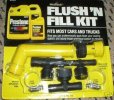Mxgrds
True Classic
it depends where the air resides in the system. Once trapped in the radiator it will never finds it way back to the tank. Hence the bleed nipple on the rad. Especially not when the outlet is on the bottom. The air in the rad will push the flow to the lower part of the rad, limiting the cooling capacity. The volume the air takes in the rad needs to be compensated somewhere. Most likely the level in the tank rises until the pressure cap releases the over pressure, being air of coolant. When the air cools down, an underpressure in the tank happens. Air will be sucked in (The system is airtight when pressurised, but not for underpressure. Slowly more air and less coolant wil be in the system. This is the process how air in the rad limits the cooling capacity causing blow head gaskets. (Been thereThat's my point, the air was already in there. The molecules of air and water will mix just from the circulation. Agitation speeds it up, but there are a finite number of those molecules in the contained space and it cannot create more than already exists. In other words, it may distribute the existing air more but it won't make more of it. So eventually that air will come back to the tank - as the hot/cold cycles and circulation happen. That's why the air space in the tank doesn't keep getting larger (unless you have a leak).
Unless you switch (unknowingly) the hoses on the rad. Now the outlet is at the top, at the same place air in the rad will collect. but now it finds itself in the strong flow of the outgoing coolant. It is most likely the air will travel back with the fast flowing coolant to the thermostathouse and hopefully into the overflow to the tank. Disadvantage of switched hoses is the thermoswitch for the radfan is now on the opposite side of temperature. It will go either late or early.

